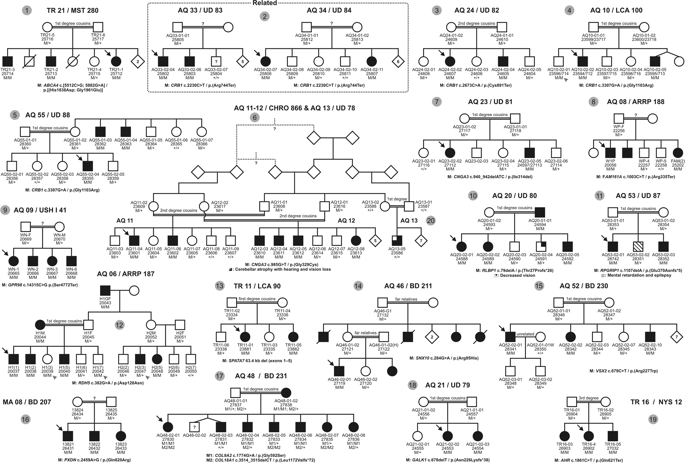当前位置:
X-MOL 学术
›
Eur. J. Hum. Genet.
›
论文详情
Our official English website, www.x-mol.net, welcomes your feedback! (Note: you will need to create a separate account there.)
Unraveling the genetic cause of hereditary ophthalmic disorders in Arab societies from Israel and the Palestinian Authority.
European Journal of Human Genetics ( IF 5.2 ) Pub Date : 2020-01-02 , DOI: 10.1038/s41431-019-0566-3 Anja K Mayer 1, 2 , Ghassan Balousha 3 , Rajech Sharkia 4, 5 , Muhammad Mahajnah 6, 7 , Suhail Ayesh 8 , Martin Schulze 2, 9 , Rebecca Buchert 9 , Ditta Zobor 10 , Abdussalam Azem 11 , Ludger Schöls 12, 13 , Peter Bauer 9 , Bernd Wissinger 1
European Journal of Human Genetics ( IF 5.2 ) Pub Date : 2020-01-02 , DOI: 10.1038/s41431-019-0566-3 Anja K Mayer 1, 2 , Ghassan Balousha 3 , Rajech Sharkia 4, 5 , Muhammad Mahajnah 6, 7 , Suhail Ayesh 8 , Martin Schulze 2, 9 , Rebecca Buchert 9 , Ditta Zobor 10 , Abdussalam Azem 11 , Ludger Schöls 12, 13 , Peter Bauer 9 , Bernd Wissinger 1
Affiliation

|
Visual impairment due to inherited ophthalmic disorders is amongst the most common disabilities observed in populations practicing consanguineous marriages. Here we investigated the molecular genetic basis of an unselected broad range of ophthalmic disorders in 20 consanguineous families from Arab villages of Israel and the Palestinian Authority. Most patients had little or very poor prior clinical workup and were recruited in a field study. Homozygosity mapping followed by candidate gene sequencing applying conventional Sanger sequencing or targeted next generation sequencing was performed in six families. In the remaining 14 families, one affected subject per family was chosen for whole exome sequencing. We discovered likely disease-causing variants, all homozygous, in 19 of 20 independent families (95%) including a previously reported novel disease gene for congenital nystagmus associated with foveal hypoplasia. Moreover, we found a family in which disease-causing variants for two collagenopathies - Stickler and Knobloch syndrome - segregate within a large sibship. Nine of the 19 distinct variants observed in this study were novel. Our study demonstrated a very high molecular diagnostic yield for a highly diverse spectrum of rare ophthalmic disorders in Arab patients from Israel and the Palestinian Authority, even with very limited prior clinical investigation. We conclude that 'genetic testing first' may be an economic way to direct clinical care and to support proper genetic counseling and risk assessment in these families.
中文翻译:

从以色列和巴勒斯坦权力机构了解阿拉伯社会遗传性眼科疾病的遗传原因。
在患有近亲婚姻的人群中,由于遗传性眼科疾病导致的视力障碍是最常见的残疾。在这里,我们调查了来自以色列阿拉伯村庄和巴勒斯坦权力机构的20个近亲家庭的未选定的广泛眼科疾病的分子遗传基础。大多数患者先前的临床检查很少或非常差,并在现场研究中被招募。在六个家族中进行了纯合性作图,然后应用常规的Sanger测序或靶向的下一代测序进行候选基因测序。在其余的14个家庭中,每个家庭选择一名受影响的受试者进行全外显子组测序。我们发现了可能的致病变体,都是纯合子,20个独立家庭中有19个(95%)包括先前报道的与中心凹发育不良相关的先天性眼球震颤的新型疾病基因。此外,我们发现了一个家族,其中两个胶原病的致病变体-Stickler和Knobloch综合征-在大的同胞中隔离。在这项研究中观察到的19个不同变体中有9个是新颖的。我们的研究表明,即使先前的临床研究非常有限,对于来自以色列和巴勒斯坦权力机构的阿拉伯患者而言,对于多种多样的罕见眼科疾病,其分子诊断率也很高。我们得出结论,“先进行基因检测”可能是指导临床治疗并支持这些家庭进行适当的遗传咨询和风险评估的经济方法。此外,我们发现了一个家族,其中两个胶原病的致病变体-Stickler和Knobloch综合征-在大的同胞中隔离。在这项研究中观察到的19个不同变体中有9个是新颖的。我们的研究表明,即使先前的临床研究非常有限,对于来自以色列和巴勒斯坦权力机构的阿拉伯患者而言,对于多种多样的罕见眼科疾病,其分子诊断率也很高。我们得出结论,“先进行基因检测”可能是指导临床治疗并支持这些家庭进行适当的遗传咨询和风险评估的经济方法。此外,我们发现了一个家族,其中两个胶原病的致病变体-Stickler和Knobloch综合征-在大的同胞中隔离。在这项研究中观察到的19个不同变体中有9个是新颖的。我们的研究表明,即使先前的临床研究非常有限,对于来自以色列和巴勒斯坦权力机构的阿拉伯患者而言,对于多种多样的罕见眼科疾病,其分子诊断率也很高。我们得出结论,“先进行基因检测”可能是指导临床治疗并支持这些家庭进行适当的遗传咨询和风险评估的经济方法。我们的研究表明,即使先前的临床研究非常有限,对于来自以色列和巴勒斯坦权力机构的阿拉伯患者中的多种多样的罕见眼科疾病,其分子诊断率也很高。我们得出结论,“先进行基因检测”可能是指导临床护理并支持这些家庭进行适当的遗传咨询和风险评估的经济方法。我们的研究表明,即使先前的临床研究非常有限,对于来自以色列和巴勒斯坦权力机构的阿拉伯患者中的多种多样的罕见眼科疾病,其分子诊断率也很高。我们得出结论,“先进行基因检测”可能是指导临床护理并支持这些家庭进行适当的遗传咨询和风险评估的经济方法。
更新日期:2020-01-02
中文翻译:

从以色列和巴勒斯坦权力机构了解阿拉伯社会遗传性眼科疾病的遗传原因。
在患有近亲婚姻的人群中,由于遗传性眼科疾病导致的视力障碍是最常见的残疾。在这里,我们调查了来自以色列阿拉伯村庄和巴勒斯坦权力机构的20个近亲家庭的未选定的广泛眼科疾病的分子遗传基础。大多数患者先前的临床检查很少或非常差,并在现场研究中被招募。在六个家族中进行了纯合性作图,然后应用常规的Sanger测序或靶向的下一代测序进行候选基因测序。在其余的14个家庭中,每个家庭选择一名受影响的受试者进行全外显子组测序。我们发现了可能的致病变体,都是纯合子,20个独立家庭中有19个(95%)包括先前报道的与中心凹发育不良相关的先天性眼球震颤的新型疾病基因。此外,我们发现了一个家族,其中两个胶原病的致病变体-Stickler和Knobloch综合征-在大的同胞中隔离。在这项研究中观察到的19个不同变体中有9个是新颖的。我们的研究表明,即使先前的临床研究非常有限,对于来自以色列和巴勒斯坦权力机构的阿拉伯患者而言,对于多种多样的罕见眼科疾病,其分子诊断率也很高。我们得出结论,“先进行基因检测”可能是指导临床治疗并支持这些家庭进行适当的遗传咨询和风险评估的经济方法。此外,我们发现了一个家族,其中两个胶原病的致病变体-Stickler和Knobloch综合征-在大的同胞中隔离。在这项研究中观察到的19个不同变体中有9个是新颖的。我们的研究表明,即使先前的临床研究非常有限,对于来自以色列和巴勒斯坦权力机构的阿拉伯患者而言,对于多种多样的罕见眼科疾病,其分子诊断率也很高。我们得出结论,“先进行基因检测”可能是指导临床治疗并支持这些家庭进行适当的遗传咨询和风险评估的经济方法。此外,我们发现了一个家族,其中两个胶原病的致病变体-Stickler和Knobloch综合征-在大的同胞中隔离。在这项研究中观察到的19个不同变体中有9个是新颖的。我们的研究表明,即使先前的临床研究非常有限,对于来自以色列和巴勒斯坦权力机构的阿拉伯患者而言,对于多种多样的罕见眼科疾病,其分子诊断率也很高。我们得出结论,“先进行基因检测”可能是指导临床治疗并支持这些家庭进行适当的遗传咨询和风险评估的经济方法。我们的研究表明,即使先前的临床研究非常有限,对于来自以色列和巴勒斯坦权力机构的阿拉伯患者中的多种多样的罕见眼科疾病,其分子诊断率也很高。我们得出结论,“先进行基因检测”可能是指导临床护理并支持这些家庭进行适当的遗传咨询和风险评估的经济方法。我们的研究表明,即使先前的临床研究非常有限,对于来自以色列和巴勒斯坦权力机构的阿拉伯患者中的多种多样的罕见眼科疾病,其分子诊断率也很高。我们得出结论,“先进行基因检测”可能是指导临床护理并支持这些家庭进行适当的遗传咨询和风险评估的经济方法。


























 京公网安备 11010802027423号
京公网安备 11010802027423号